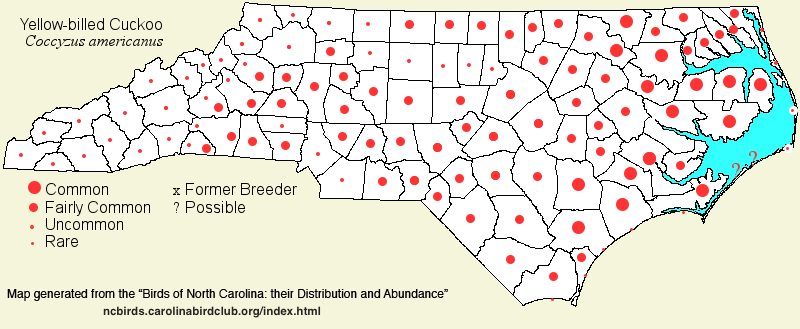 |  |
|
Yellow-billed Cuckoo - Coccyzus americanus CUCULIDAE Members: | Search Common: Search Scientific: |
|
|
|||||||
| General Comments | The Yellow-billed Cuckoo is a widespread breeding bird across the state, nesting in every county. However, it is not numerous or overly widespread in the mountains. Cuckoos are among the few species that feed on hairy caterpillars, and their abundance can be quite variable, depending on local outbreaks of certain moth species and their larvae (i.e., caterpillars). This species is seldom found away from hardwood trees; favored habitats are somewhat moist, such as bottomlands. However, they also breed in swamps, upland hardwood and mixed forests, and in younger forests, as long as there is a good component of hardwoods. They normally disappear from the state abruptly in mid-fall, and there are no winter records (after 5 Dec). | ||||||
| Breeding Status | Breeder | ||||||
| NC BRC List | Definitive | ||||||
| State Status | |||||||
| U.S. Status | |||||||
| State Rank | S5B | ||||||
| Global Rank | G5 | ||||||
| Coastal Plain | Summer resident, breeding. Fairly common to common across the region, except uncommon to locally absent on coastal islands. Most numerous in bottomlands. Normal occurrence: late Apr to mid-Oct; casually from late Mar to late Nov (29 Nov); no records from Dec - Feb. Peak counts, all surprisingly at Cape Lookout (which obviously concentrates this species after a cold front): 150+, 14 Oct 1979; 100, 5 Oct 2014; 50, 12 Oct 1980; 50+, 23 Oct 2016. | ||||||
| Piedmont | Summer resident, breeding. Fairly common and reasonably widespread across the region, though only uncommon to locally fairly common in foothill ranges. Normal occurrence: late Apr to early Oct; a report from 11 Mar 1954 is remarkably early, if correct; a handful of Nov records; no records from Dec - Feb. Peak counts: ? | ||||||
| Mountains | Summer resident, breeding. Uncommon in the lower elevations (below about 3,500 feet); rare to uncommon at middle elevations (3,500 to 4,500 feet); generally absent above about 4,500 feet as a breeder. Not obviously more numerous in migration. Normal occurrence: very late Apr or early May to early Oct. Remarkable was a specimen found at Swannanoa (Buncombe) on 5 Dec 1985 [Chat 51:21 link], the state's only winter record. Peak counts: ? | ||||||
| Finding Tips |
This species can normally be found away from the mountains in a day of birding. A count or 10 or more can be made in a day in the Coastal Plain, such as from a canoe along a large river. They are hard to intentionally search for, but the calls/songs carry for long distances. In the mountains, you may have to work a bit to see or hear one. *** | ||||||
| Attribution | LeGrand[2022-02-08], LeGrand[2020-02-08], LeGrand[2019-04-18] | ||||||
| NC Map Map depicts all counties with a report (transient or resident) for the species. | Click on county for list of all known species. |
| NC Breeding Season Map Map depicts assumed breeding season abundance for the species. |  |